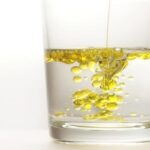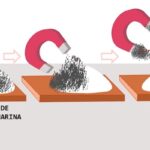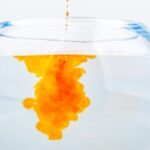We explain what chromatography is, how it is used to separate mixtures, what its phases are, what types exist and examples.

What is chromatography?
Chromatography is a method of separating complex mixtures which is widely used in various branches of science. It can be used to quantify, identify and separate the components of a mixture. To do this, it uses the principle of selective retention, which consists of the different behavior of the components of a mixture on a specific support (such as paper, a gas, a liquid, a resin) and a liquid or gaseous phase that flows through of the support.
In this way, chromatography uses various techniques that take advantage of the differences in the retention rate of each component, and can separate, identify and quantify them.
In many cases it is key adsorption (different from the absorption, which refers to the diffusion of a component from one phase to another), a concept that refers to the process by which particles are retained on a surface. According to the difference in adsorption rates on a support and the affinity of the components of the mixture for this support, they can be separated and then quantified or identified.
In general, all types of chromatography depend on a series of instruments chemical compounds and certain technology. Due to this, it is important to know some concepts to understand how chromatographic techniques work:
- Stationary phase. It is a substance that remains immobile while chromatography is performed.
- Mobile phase It is the substance that moves during chromatography. It can be a liquid or a gas. The sample containing the analyte is administered into the mobile phase.
- Analytes They are the substances that are going to be separated, quantified and/or identified using chromatography, that is, they are the substances that are going to be analyzed.
- Sample It is the mixture that is going to be analyzed. It may be made up of one or several analytes, and other components that may not be of interest, from which the analytes will be separated.
- Retention time. It is the time it takes for an analyte to pass from the column or system through which the mobile phase passes, to the detector (equipment that can give a detection signal using some property of the analyte).
- Selectivity It is the ability to differentiate each component in the mixture.
- Eluent It also refers to the mobile phase when it leaves the chromatographic column.
The chromatographic method consists of inoculating a sample into a stationary phase or mobile phase (depending on the type of chromatographic technique). Then, if, for example, the mobile phase is the one containing the sample, it passes through a certain stationary phase.
The separation of the analytes will depend on the affinity of each of the components by both the stationary phase and the mobile phase. Depending on their nature, some substances will tend to move with the mobile phase and others will tend to remain on the stationary phase.
See also: Colloid
Types of chromatography
Depending on the technology used, the nature of the support (stationary phase) and the mobile substance (mobile phase), the following types of chromatography can be differentiated:
- Paper chromatography. The stationary phase is formed by a strip of filter paper. The sample to be analyzed is placed in the form of a drop on one end of the paper. Then the strip of paper is immersed in a container where the mobile phase is located, taking into account that the end where the sample is placed is at the bottom of the paper. The mobile phase rises by capillarity, dragging the sample with it and separating each component according to its affinity for the stationary phase. This type of chromatography is mainly used when each component of the sample has a different color, then you can see the display of colors on the paper to identify them.
- Thin layer chromatography. The operation of this technique is similar to that of paper chromatography, but in this case the stationary phase is constructed by depositing a polar resin (almost always silica gel) on a glass or aluminum plate. A certain amount of the sample is placed 1cm from the lower edge of the plate. This plate is then immersed, taking into account that the end containing the sample must be facing down, into a container containing the mobile phase. The mobile phase rises by capillarity, separating the components of the sample.


- Column chromatography. The stationary phase is placed inside a column that can be made of glass or stainless steel, among other materials. The mobile phase can be liquid or gas. The sample is placed at the top of the column and allowed to descend with the mobile phase using gravity. In this way, column chromatography can be classified as:
- Solid-liquid chromatography. The stationary phase is solid and the mobile phase is liquid.
- Liquid-liquid chromatography Both phases are liquid.
- Liquid-gas chromatography. The stationary phase is liquid and the mobile phase is gaseous.
- Solid-gas chromatography. The stationary phase is a solid and the mobile phase is a gas.
On the other hand, depending on the type of interaction of the analyte between the stationary and mobile phases, we have the following types of chromatography:
- Adsorption chromatography In this type of chromatography the stationary phase is a solid, while the mobile phase is a liquid. The substance that forms the stationary phase can be alumina (Al2EITHER3), silica (SiO2) or ion exchange resins (matrices that have electrostatically active sites, due to which the analyte is retained in them by electrostatic interaction). The mobile phase can be formed by a solvent or a mixture of solvents. Some components of the mixture will be retained more strongly than others, this is how separation occurs.
- Partition chromatography. It occurs when the separation of the analytes from the mixture occurs due to differences in their solubilities or polarities between the stationary phase and the mobile phase, both phases being immiscible liquids. Stationary phase technology has advanced and there are already varieties of liquids embedded in solids and resins that are used for this purpose. In this sense, there are two types of cormatography depending on the polarity of the stationary phase and the mobile phase:
- In normal phase The stationary phase is polar and the mobile phase is nonpolar.
- In reverse phase. The stationary phase is nonpolar and the mobile phase is polar.
- Ion exchange chromatography When the stationary phase is solid and has ionizable functional groups, that is, charged, which are capable of exchanging their charge with the analyte. It can be classified into:
- Cation exchange chromatography The stationary phase contains negatively charged functional groups, so it retains (positively charged) cations.
- Anion exchange chromatography. The stationary phase contains positively charged functional groups, so it retains (negatively charged) anions.
- Molecular exclusion chromatography. The stationary phase is a porous material through which the analytes elute, depending on their sizes. In this type of chromatography there is no type of physical or chemical interaction between the analytes and the stationary phase. The largest analytes elute first, that is, they are not retained in the stationary phase. While the smaller analytes are trapped in the pores of the stationary phase and leave it as the mobile (liquid) phase is passed.
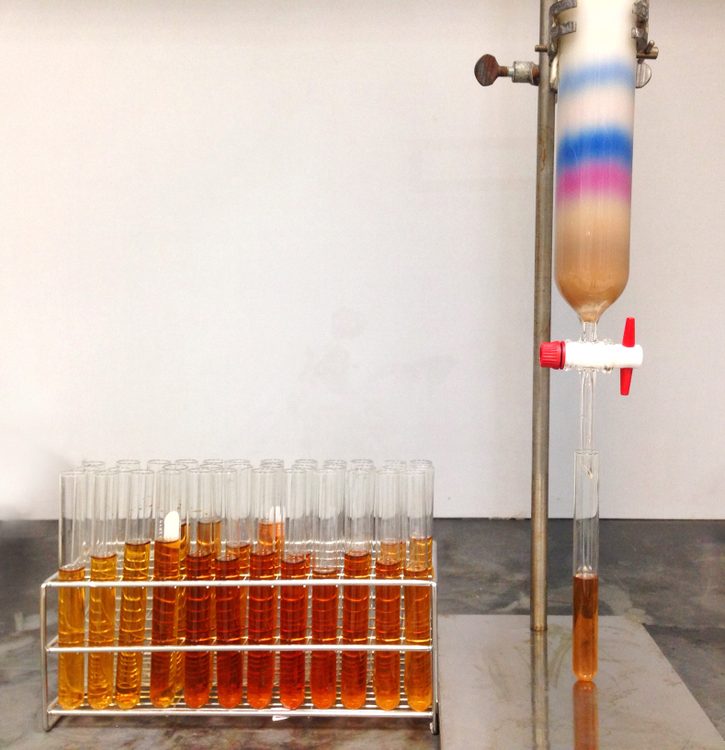

With the advancement of knowledge and technology, chromatographic techniques were perfected and it has increasingly been possible to separate, identify and quantify the substances present in a mixture more accurately. Two examples of advanced chromatographies are HPLC (High Performance Liquid Chromatography) and GC (Gas Chromatography).
- HPLC It consists of a type of column chromatography, but whose mobile phase is pumped at high pressures through the stationary phase inside the column. The application of high pressure reduces the diffusion of analytes through the stationary phase, thus achieving better results, in addition to reducing working times.
- GC. The mobile phase is a gas and the stationary phase can be a solid or a liquid. The sample is volatilized before being injected into the chromatographic column, as it must be gaseous for the carrier gas to transport it.
Examples of chromatography
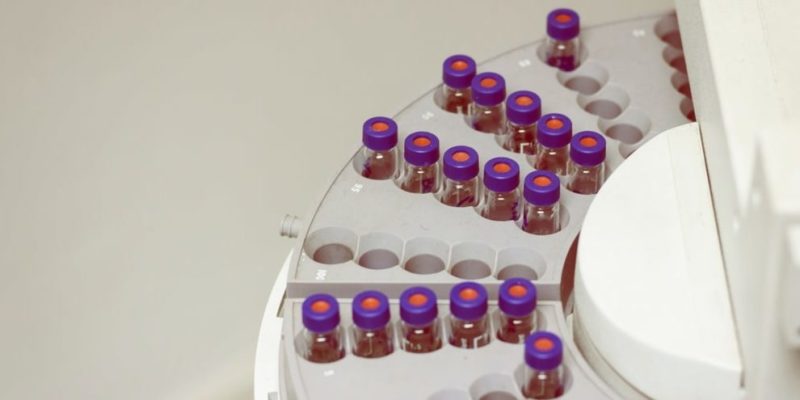
Some everyday examples of the application of chromatography are:
- Spilled wine on a white tablecloth An accident at dinner time will allow us to observe, as the wine dries through contact with air, the various substances that make it up. Each one will dye the white of the fabric a different tone or color, and they can be identified separately, something that would normally be impossible.
- Blood test Chromatography of blood samples is often carried out to identify the substances contained in it, normally imperceptible given that it is a very complex mixture. To do this, the color that the blood reflects on a support or when subjected to a specific light is observed.
- Urine tests Like blood, urine is a mixture of various compounds, some solids and others liquids, whose presence or absence can reveal details about the functioning of the body. Chromatographic separation can be carried out to detect unusual residues, such as blood, salts, glucose or illegal substances.
- Review of a crime scene Something we often see in movies: researchers take fabrics, fibers, fabrics or other supports and observe the separation by adhesion of the different substances spilled on them, such as semen or blood, even when with the naked eye they could pass unnoticed.
- Food health checks Starting from the fact that food specialists know the reaction of food components when subjected to a chromatographic spectrum, this technique can be used to detail in a sample if there is any type of undue substance in them, product of microbial agents or some type of contamination, before the product goes on the market and puts people's health at risk.
Continue with: Chemical solution
References
- “Chromatography” on Wikipedia.
- “Chromatography” in Biomodel.
- “What is chromatography?” in science area.
- “Separation techniques: Chromatography” in US National Library of Medicine.
- “Basics of Chromatography” at Khan Academy (English).
- “Chromatography” in The Encyclopaedia Britannica.

